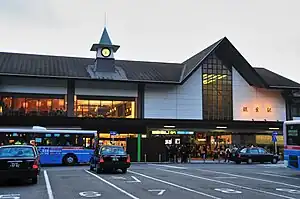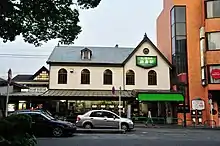Kamakura Station
Kamakura Station (鎌倉駅, Kamakura-eki) is a railway station on the Yokosuka Line in Kamakura, Kanagawa, Japan, operated by East Japan Railway Company (JR East).
JO07 JS07  Kamakura Station 鎌倉駅 | ||||||||||||||||||||||||||
|---|---|---|---|---|---|---|---|---|---|---|---|---|---|---|---|---|---|---|---|---|---|---|---|---|---|---|
 JR Kamakura Station | ||||||||||||||||||||||||||
| General information | ||||||||||||||||||||||||||
| Location | 1-1-1 Komachi, Kamakura, Kanagawa (神奈川県鎌倉市小町一丁目1-1) Japan | |||||||||||||||||||||||||
| Operated by | ||||||||||||||||||||||||||
| Line(s) | ||||||||||||||||||||||||||
| Connections |
| |||||||||||||||||||||||||
| History | ||||||||||||||||||||||||||
| Opened | 16 June 1889 | |||||||||||||||||||||||||
| Passengers | ||||||||||||||||||||||||||
| FY2008, JR East | 40,374 daily | |||||||||||||||||||||||||
| Services | ||||||||||||||||||||||||||
| ||||||||||||||||||||||||||
Lines
Kamakura Station is served by the Yokosuka Line and Shōnan-Shinjuku Line. It is located 4.5 km (2.8 mi) from the junction at Ōfuna Station, and 53.9 km (33.5 mi) from Tokyo Station. It is also the terminal station for the Enoshima Electric Railway, whose station is adjacent.
Station layout
JR East Station
JR Kamakura Station has a single island platform connected to the station building by two underpasses. Beside the two main lines there is also one additional line where trains can stop. Because the platform is built on a hill, its elevation is higher than the ticket gates and Enoden platform.
Because the station serves a popular tourist area, there are many extra trains at weekends and holidays. However, in spite of the extra side line for trains to stop in, trains cannot change direction at this station, so many trains meant to serve this station have to run between Zushi and Tamachi Depot. In the evening, passenger trains also run from Tamachi Depot to Zushi, then back to Kamakura.
In most areas with stairs there are elevators and escalators. There are also two automatic vending machines for Green car (first class) tickets for use with Suica on the platform.
At the station's east exit there were previously several shops, especially restaurants. However, this area was rebuilt as Ekisuto Kamakura (エキスト鎌倉), a shopping facility which opened on 31 October 2007. Besides a convenience store and a Kamakura tourist information center, the first floor consists entirely of eateries. There is a "Midori no Madoguchi" staffed ticket counter the east entrance, which operates during the hours 7:00 to 20:00.
Enoshima Electric Railway Station

The Enoshima Electric Railway (Enoden) has a ground-level bay platform around two tracks. The platforms are numbered in coordination with the JR lines, so that Enoden uses lines designated as 3 through 5, the signs of which are controlled by machine, usually displaying only 3 and 4. Line 5 is used only for the early morning train that departs at 5:47. During this time, there is already a train in line 3, and in order to change the order of trains on the tracks (that of two-car and four-car trains) line 5 is used. In the periods around New Year, Golden Week, and other busy times, a special, staggered schedule using the two lines 3 and 5.
An entrance ticket at other Enoden stations is 190 yen (as of September 2012), but in order to match JR, which shares the Kamakura station, the ticket is 130 yen at Kamakura station, although this ticket can only be used on the Enoden side.
At the time of introduction of Pasmo, automatic ticket gates were installed in both Kamakura Station and Fujisawa Station.
JR platforms
| 1 | JO Yokosuka Line | for Zushi, Yokosuka, and Kurihama |
| JS Shōnan-Shinjuku Line | for Zushi | |
| 2 | JO Yokosuka Line | for Ōfuna, Yokohama, Tokyo, Chiba Narita Line for Narutō / Narita Airport (via Chiba) Uchibō Line for Kimitsu (via Chiba) |
| JS Shōnan-Shinjuku Line | for Ōfuna, Yokohama, Shinjuku, Ōmiya, and Utsunomiya |
Enoshima Electric Railway platforms
| 3 | ■ Enoshima Electric Railway | for Hase, Enoshima, and Fujisawa |
| 4 | ■ Enoshima Electric Railway | Alighting passengers only |
| 5 | ■ Enoshima Electric Railway | for Hase, Enoshima, and Fujisawa |
Bus service
Kamakura station bus terminal
- Bus stop number 1
| No. | Via | Destination | Company | Office |
|---|---|---|---|---|
| F1 | Kotokuin・Daibutsumae | Fujisawa Station Minamiguchi | Enoden Bus | Shonan |
| K1 | Kotokuin・Daibutsumae | Kikyoyama | ||
| K3 | Kotokuin・Daibutsumae | Shonanshako |
- Bus stop number 2
| No. | Via | Destination | Company | Office |
|---|---|---|---|---|
| airport bus | Non stop | Haneda Airport | Keihin Kyuko Bus | Kamakura |
| A21 | Ofuna Station | Kamiooka Station | Enoden Bus | Yokohama |
| N2 | Joraku-ji | Ofuna Station | Enoden Bus | Kamakura |
| K4 | Ofuna Station | Hongodai Station | Enoden Bus | Kamakura |
| K5 | Hase Station | Shichirigahama | Enoden Bus | Shonan |
| airport bus | Non stop | Haneda Airport | Enoden Bus | |
| expressway bus | Sakaishi Station | Nankai Bus |
- Bus stop number 3
| No. | Via | Destination | Company | Office |
|---|---|---|---|---|
| 鎌30 | Midorigaokairiguchi | Shinzushi Station | Keihin Kyuko Bus | Kamakura |
| 鎌31 | Midorigaokairiguchi | |||
| sightseeing bus | circular-route | Kamakura Station | Enoden Bus | Shonan |
- Bus stop number 4
| No. | Via | Destination | Company | Office |
|---|---|---|---|---|
| 鎌20 | Kamakura-gu | Keihin Kyuko Bus | Kamakura |
- Bus stop number 5
| No. | Via | Destination | Company | Office |
|---|---|---|---|---|
| 鎌23 | Kamakuragomeisui | Kamakura Gakuen Seimon-mae | Keihin Kyuko Bus | Kamakura |
| 鎌24 | Kamakura Gakuen Seimon-mae | Kanazawa-hakkei Station | ||
| 鎌36 | circular-route | Kamakura Station |
- Bus stop number 6
| No. | Via | Destination | Company | Office |
|---|---|---|---|---|
| 鎌2 | Daibutsumae | Kajiwara | Keihin Kyuko Bus | Kamakura |
| 鎌3 | Daibutsumae・Fujimidai(circular-route) | Kamakura Station | ||
| 鎌4 | Daibutsumae | Kamakurayama | ||
| 鎌5 | Daibutsumae・Kamakurayama | Suwagaya | ||
| 鎌6 | Daibutsumae・Kamakurayama | Enoshima | ||
| 船7 | Daibutsumae・Kajiwaraguchi | Ofuna Station | ||
| 船8 | Daibutsumae・Kajiwaraguchi・Kajiwara | Ofuna Station | ||
| 船9 | Daibutsumae・Kamakurayama | Ofuna Station |
- Bus stop number 7
| No. | Via | Destination | Company | Office |
|---|---|---|---|---|
| 鎌11 | Kaiganbashi(circular-route) | Kamakura Station | Keihin Kyuko Bus | Kamakura |
| 鎌12 | Kuhonji(circular-route) | Kamakura Station | ||
| 鎌40 | Kotsubo | Zushi Station | ||
| 鎌41 | Kotsubo |
Kamakura Shiyakusyo-mae bus stop
| No. | Via | Destination | Company | Office |
|---|---|---|---|---|
| K6 | Yakumojinja | Kikyoyama | Enoden Bus | Shonan |
| 鎌50 | Yakumojinja | Yamanoue Rotary | Keihin Kyuko Bus | Kamakura |
| 鎌51 | Yakumojinja | Kamakura Chuo Koen |
History
Kamakura Station opened on 16 June 1889 as a station on a spur line from Ōfuna on the Japanese Government Railways (JGR), the pre-war predecessor to the Japan National Railways (JNR) to serve the Yokosuka Naval Arsenal and related Imperial Japanese Navy facilities at Yokosuka. This line was renamed the Yokosuka Line in October 1909. The terminus of the Enoshima Electric Railway was relocated to Kamakura Station on 1 March 1949. All freight operations were stopped in 1962. The station building was rebuilt in October 1984. The station came under the management of JR East upon the privatization of the Japanese National Railways (JNR) on 1 April 1987.
Station numbering was introduced to the Enoshima Electric Railway January 2014 with Kamakura being assigned station number EN15.[1][2] The JR East platforms received station numbers in 2016 with Kamakura being assigned station numbers JO07 for the Yokosuka line and JS07 for the Shonan-Shinjuku line.[3][4]
References
- Harris, Ken and Clarke, Jackie. Jane's World Railways 2008–2009. Jane's Information Group (2008). ISBN 0-7106-2861-7
- "2014年1月から駅ナンバリングを順次導入します!" [From January 2014, station numbering will be introduced sequentially!] (PDF). odakyu.jp (in Japanese). 24 December 2013. Archived from the original (PDF) on 26 October 2022. Retrieved 9 January 2023.
- Kusamichi, Yoshikazu (28 December 2013). "小田急グループ、鉄道から海賊船まで通しの駅番号…2014年1月から順次導入" [Odakyu Group, station numbers from railways to pirate ships, Introduced sequentially from January 2014]. Response Automotive Media (in Japanese). Archived from the original on 22 June 2020. Retrieved 10 January 2023.
- "⾸都圏エリアへ 「駅ナンバリング」を導⼊します" [Introduce “station numbering” to the Tokyo metropolitan area] (PDF). jreast.co.jp (in Japanese). 6 April 2016. Archived from the original (PDF) on 7 December 2022. Retrieved 7 January 2023.
- Kusamachi, Yoshikazu (7 April 2016). "JA・JK・JT・AKB…JR東日本、首都圏で駅ナンバリングなど導入へ" [JA, JK, JT, AKB … JR East to introduce station numbering in the Tokyo metropolitan area]. Response Automotive Media (in Japanese). Archived from the original on 6 August 2022. Retrieved 7 January 2023.
External links
- Kamakura Station information (JR East) (in Japanese)
- Enoden website (in Japanese)